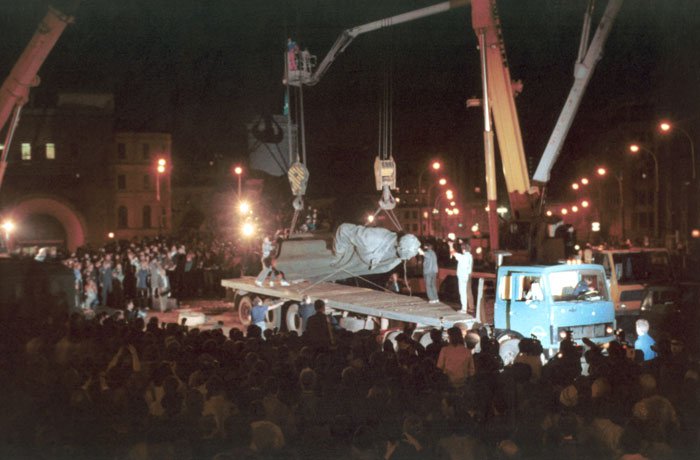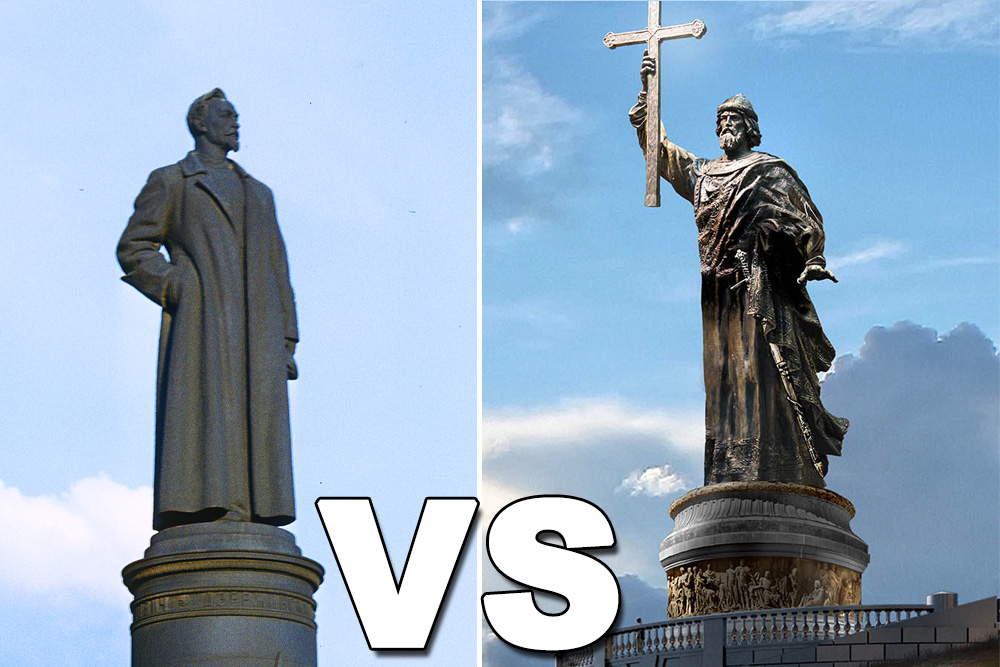The Communist Party of the Russian Federation has obtained permission from the Moscow City Elections Commission to hold a referendum on whether to return the statue of Felix Dzerzhinsky, the first Soviet police chief, to Lubyanka Square in Moscow in front of the FSB building.
Welcome to our column, Russia Update, where we will be closely following day-to-day developments in Russia, including the Russian government’s foreign and domestic policies.
The previous issue is here.
UPDATES BELOW
Russia This Week:
– Is ‘Novorossiya’ Really Dead?
– From Medal of Valor to Ubiquitous Propaganda Symbol: the History of the St. George Ribbon
– What Happened to the Slow-Moving Coup?
– Can We Be Satisfied with the Theory That Kadyrov Killed Nemtsov?
– All the Strange Things Going On in Moscow
Special features:
– With Cash and Conspiracy Theories, Russian Orthodox Philanthropist Malofeyev is Useful to the Kremlin
– Alexey Navalny On the Murder of Boris Nemtsov
– Theories about Possible Perpetrators of the Murder of Boris Nemtsov
– Novaya Gazeta Releases Sensational Kremlin Memo
Please help The Interpreter to continue providing this valuable information service by making a donation towards our costsâ€.
A student of Moscow State University who ran away to join ISIS was returned to Russia after being detained on the Turkish-Syrian border, Novaya Gazeta reported, citing RIA Novosti
Varvara Karaulova, 19, was questioned as a witness regarding
her recruitment into ISIS, Aleksandr Karabanov, the family’s lawyer
reported (translation by The Interpreter):
She is home, and talking to her family. I think they have things to discuss. Her condition and mood are normal.
Karaulova
was already questioned by Turkish intelligence last week. An
investigation continues. Authorities were able to track her through her
mobile phone.
While initially only Karaulova’s case was discussed when she went missing, later reports indicated 13 Russian citizens in a group had been detained.
— Catherine A. Fitzpatrick
A Russian military pilot has carried out an incredibly risky maneuver, flying within ten feet of a large US reconnaissance aircraft in international airspace. ABC reports:
On May 30, a Russian Sukhoi Su-27 fighter jet came very close to a large U.S. RC-135 reconnaissance aircraft, officials said. It was unclear whether the U.S has filed any formal, diplomatic complaint with the Russians.
CNN adds:
The Russian jet flew alongside the U.S. plane at the same altitude, broke off, and then shadowed the plane before leaving the area in the May 30 incident, the officials said. The U.S. aircraft took no evasive measures, and no other details were immediately available. Military officials could not say whether a diplomatic protest had been filed.
IBN also mentions that this is not the only incident like this in the last several months:
A similar incident took place in April when a U.S. RC-135U aircraft flying a routine flight over the Baltic Sea was intercepted by a Russian SU-27 Flanker. The incident, which occurred in international airspace north of Poland, was reportedly described by Pentagon officials as “unsafe and unprofessional” because of the “aggressive maneuvers” performed by the Russian pilot “in close proximity to their aircraft and its high rate of speed.”
It’s also worth noting that on the same day as this latest incident, May 30, a Russian fighter jet buzzed a US naval ship, prompting the crew to film the incident and release the video:
These aggressive actions are likely a show of force, but they are also likely designed to probe NATO’s response to incidents such as these.
— James Miller
Translation: Tolokonnikova in prison garb tried to sew a Russian flag on Bolotnaya Square. Photo report by Yevgeny Feldman
Translation: Nadezhda Tolokonnika was detained at an unauthorized actions in Moscow.
Translation: We were pushed into a police van for the fact that we were sewing a Russian flag in prison uniforms on Bolotnaya Square. What a holiday!
— Catherine A. Fitzpatrick
Last night, June 11, Gazeta.ru reported that the Moscow City Elections Commission has just ruled to give permission to the Communist Party of the Russian Federation (KPRF) to conduct a referendum on restoring the statue of Felix Dzerzhinsky, the Soviet Union’s first secret police chief after the 1917 Revolution.
For a number of years, the Communists’ request was simply rejected and their efforts to file lawsuits failed; now the time is favorable.
If the Communists manage to gather 146,000 signatures within 28 days, then on July 7 or 8 they will be able to hold a referendum on three issues: regarding educational reforms; health reforms; and return of the statue of “Iron Felix” as he was known to Lubyanka Square.
Lubyanka is the location of the Federal Security Service, Russia’s domestic intelligence agency which is the successor of the KGB, before that known by various names at various times, but originally the Cheka under Dzerzhinsky (for the initials for the words “Extraordinary Commission”) — the name still used informally today.
On August 21, 1991, the crowd of demonstrators protesting the hard-line coup led by then-KGB chief Vladimir Kryuchkov demanded that the 15-ton statue of Dzerzhinsky be torn down. Five cranes were summoned to do the job. The statue was put in a garden with other dismantled monuments to figures of the Soviet tyranny.

To be sure, there have been numerous appeals to bring Dzerzhinsky back over the years, although they were rejected.
A poll in 2013 found that 45% of Russians favored returning it, with 25% unconditionally opposed to it. A smaller bust of Dzerzhinsky was returned to Moscow police headquarters at Petrovka 38 in November 2005.
Anna Semina, the author of the article on the referendum for Gazeta.ru, says the statue “can and should be returned” but acknowledged “that doesn’t mean most Muscovites have such a point of view.”
A source told Gazeta.ru that it would “extremely difficult” to place another figure in the spot in front of the FSB building (translation by The Interpreter):
On Lubyanka, the entire ensemble was placed around the Dzerzhinsky monument. All the more because now the monument has been restored, and it is in excellent form, so to say. In its current place — Muzeone — it is completely lost among the other abandoned sculptures.
In October 1991, Memorial Society arranged to place a stone from the Solovki Monastery, the first Soviet concentration camp for political prisoners, near the Lubyanka in memory of the victims of communism, but this monument in a park off to the side of the square, not at the site where Dzerzhinsky’s statue once stood.
The Dzerzhinsky statue, made in 1958 by the famous Soviet sculptor Yevgeny Vuchetich was restored in 2014; the question was raised at the time whether graffiti on it saying things like “End to Civil War” and “Down with Felix” scrawled during the opposition to the coup should be preserved. The museum responsible for the sculpture park believed that it should be left on as an artifact of history.
The Russian Military Historical Society, the pro-government patriotic organization have asked to change the location of the controversial statue of Grand Prince Vladimir, because of concerns that the weight of the statue could cause landslides. University professors and students had also objected; 50,000 signatures were gathered, as it was seen as the imposition of a religious figure on a secular educational space. Now some thought is being given to putting the statue of Prince Vladimir on Lubyanka Square; other locations are Smolenskaya Square or near the Cathedral of Christ the Savior.
The issue will be debated on July 14 at the experts commission for monumental art of the Moscow City Duma.

Art work accompanying Gazeta.ru article.
There has been some commentary already on Twitter.
Russia and Putin in revenge will return the monument to Dzerzhinsky to
Lubyanka.
Translation: if you don’t like Dzerzhinsky – let’s place a monument to soldiers and officers of the NKVD divisions who died at the fronts in the Great Patriotic War. That would be just.
Meanwhile, Ukraine is moving in the opposite direction, with not only Lenin statues toppling everywhere, but last week a Dzerzhinsky statue as well.
Translation: Ukrainian nationalists took down the monument to Dzerzhinsky in Rivne Region.
President Vladimir Putin’s reversals of many of the accomplishment of
the Gorbachev and Yeltsin era of reforms in freedom of the press, association and enterprise seem commonplace now.
Yet certain
areas that once seemed as if they might remain “untouched” even under Putin — like the
rehabilitation of Stalin — have dangerously reappeared, as the 70th
anniversary of Victory Day provided an excuse for putting the
tyrant’s face on posters again. Most likely we will see Dzerzhinsky return because Putin, a former KGB officer and once intelligence chief of Russia himself, will find it fitting.
— Catherine A. Fitzpatrick